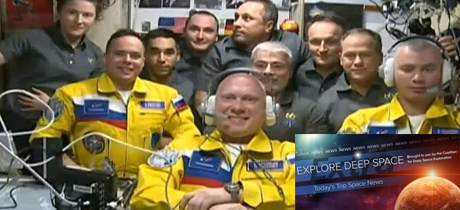In Today’s Deep Space Extra… Three cosmonauts were welcomed aboard the International Space Station. Juno snaps new photos of Io and Europa. China developing solid rockets to meet launch demand.
Human Space Exploration
Russian launch to ISS underscores some space cooperation unchanged
Spacepolicyonline.com (3/18): Cosmonauts Oleg Artemyev, Denis Matveev, and Sergei Korsakov launched to the International Space Station (ISS) on Friday aboard the Soyuz MS-21 for a six-month tour of duty. It is the first time that a Russian Soyuz launches to the ISS with a crew of all cosmonauts and no international partner astronauts. The newcomers are to replace cosmonauts Anton Shkaplerov, the ISS’s current commander, and Pyotr Dubrov and NASA’s Mark Vande Hei, who are scheduled to return to Earth on March 30 aboard the Soyuz MS-19. The cosmonauts that just launched were dressed in a distinctive yellow garb with blue trim, sparking speculation they were sending a message in support of Ukraine. Russian officials insisted the three cosmonauts were paying tribute to Bauman Moscow State Technical University, which they all attended, and which has blue and yellow among its school colors.
Space Science
Russia to work on solo Mars mission after Europe freezes joint project – Interfax
Reuters.com (3/18): The European Space Agency (ESA) announced last Thursday that it was withdrawing its support for the ExoMars mission, a joint effort with Russia. In response, Dmitry Rogozin, the head of Roscosmos, announced the Russian space agency will soon begin work on its own mission. The departure of ExoMars, whose launch was planned for September 2022 on a Russian rocket, will likely now be delayed until no earlier than 2026.
NASA spacecraft snaps gorgeous new photo of Jupiter’s moons Io and Europa
Space.com (3/20): Launched in August 2011, NASA’s Jupiter-orbiting Juno mission has transmitted recent images of the giant planet’s moons Io and Europa. Obtained on January 12 while Juno was 38,000 miles above the Jovian cloud tops, the imagery was released by NASA on March 16. Io was previously revealed to host volcanic activity. Europa is host to an ice-covered global ocean.
Lunar rovers could be dropped into lava tubes to explore their depths
Universetoday.com (3/20): The Moon’s lava tubes might offer an attractive option for a lunar base site, but also challenges. Lucas Froissart, of the Ecole Polytechnique Federale de Lausanne (EPFL), has proposed a novel lunar rover strategy for exploring the caverns, working in cooperation with Japan’s space agency. His rover concept actually involves spherical robots that could be dropped into the tubes.
Other News
Another startup joins race to provide high-speed lunar communications
SpaceNews.com (3/18): Aquarian Space, a Colorado startup, plans to establish a high-speed communications network for the Moon. The network’s first satellite is planned for launch in the first quarter of 2024 and the second in 2025, to establish continuous coverage for the lunar south pole. The region is a focus of future exploration because of large subsurface water ice deposits.
Cyber warfare gets real for satellite operators
Coalition Member in the News – Boeing
SpaceNews.com (3/20): Last week, the Satellite Industry Association joined with the Cybersecurity and Infrastructure Security Agency (CISA), part of the U.S. Department of Homeland Security, in voicing concerns over a growing cyber security threat to satellite operators and their customers given rising global geopolitical tensions. A cyber security attack in February is blamed for a disruption to internet services in Europe provided by Viasat’s KA-SAT. The incident is under investigation by French, U.S., and Ukrainian intelligence services as a potential act by Russian hackers, according to the report.
China is developing new solid rockets to boost overall space capabilities
SpaceNews.com (3/18): China is pursuing the development of a growing range of solid rockets to increase the country’s space footprint. The Jielong-3, or Smart Dragon-3, is planned for a first launch in September, according to recent state media reports. Able to launch from the land or sea from new maritime launch facilities, the new solid rocket is to provide greater flexibility while reducing pressure on China’s primary launch sites. Meanwhile, CAS Space, a Chinese Academy of Sciences spinoff, conducted ground tests for the four-stage ZK-1A solid rocket in November 2021 in preparation for a future first launch attempt. Each could be more capable than the Long March 11, which is China’s most powerful solid propellant launch vehicle.
Major Space Related Activities for the Week
Major space related activities for the week of March 20-26, 2022
Spacepolicyonline.com (3/20): The Satellite 2022 conference meets in Washington from Monday through Thursday. The American Astronautical Society’s Goddard Memorial Symposium gathers Wednesday through Friday in person and virtually from the University of Maryland with a theme, “Envisioning our future in Space.” NASA astronaut Raja Chari, and Matthias Maurer of the European Space Agency (ESA), are to team up for a spacewalk outside the International Space Station (ISS) on Tuesday. Their tasks will include coolant and power and data system upgrades, the installation of an external camera, and other maintenance duties over 6 1/2 hours. The Biden administration now plans to submit a 2023 fiscal year budget request to Congress on March 28. The Senate is in session this week. In recess, the House is prepared to meet pro forma.

